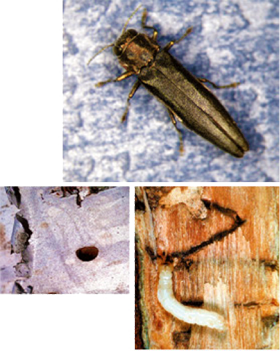Boring Insects and Their Harmful Effects on Your Landscape.
 The crackle of a campfire and the smell of roasted marshmallows always seem to bring about a familiar summer feeling. As you select the next log to throw into the fire, you may find peculiar evidence of serpentine tunnels or large holes just beneath the brittle bark. The insects responsible for creating those markings belong to the larvae of a borer, and unfortunately, may be hiding in your own backyard.
The crackle of a campfire and the smell of roasted marshmallows always seem to bring about a familiar summer feeling. As you select the next log to throw into the fire, you may find peculiar evidence of serpentine tunnels or large holes just beneath the brittle bark. The insects responsible for creating those markings belong to the larvae of a borer, and unfortunately, may be hiding in your own backyard.
There are three types of borers; round headed, flat headed, and moth borers. Although they are all uniquely different, each one is equally destructive in their own way.
Flat Headed Borer: The flatheaded borers are known for their enlarged and flattened head. The larvae appear as white, wormlike creatures and the adult beetle has a brilliant shiny metallic color. The Emerald Ash Borer and Bronze Birch Borer also belong to this family. Females lay eggs in the protected sites of the tree such as bark crevices, bark flaps, or wounds. The larvae first begin feeding on the innerbark, then bore into the sapwood and heartwood of the tree. The lifecycle of the flathead borer from egg to adult is one to two years.
What to Look For:
- Medium sized 1/4-1/2″ “D” shaped exit holes on bark
- Flattened tunnels in the sapwood
- Powdery, pale colored sawdust in the tunnels
- Discoloration or wilting of foliage
Round Headed Borers: The second type of borers are the round headed borers, also known as “long horned beetles”. The larvae of the round headed borer emerge as fleshy, cylindrical, elongated grubs with gnawing mandibles. The adults may be black or brown in color, 1″ in length, with very large black antennae. Locust borers, cottonwood borers, and redheaded ash borers are common examples of long horned beetles. The majority of round headed borers attack dead or dying trees; feeding just underneath the bark and into the heartwood. However, these borers have been known to infest healthy or slightly weakened trees.
What to Look For:
- Cone shaped holes on bark
- Sawdust in crevices or at the base of the tree
- Sap-staining of the bark and around exit holes
- Discoloration or wilting of foliage
Moth Borers: The eggs are layed by moths, turning into a caterpillar-like larvae. These white creatures are 1/8-1″ in length, with six short segmented legs behind the head and four pairs of fleshy prolegs on the abdomen. The adult moth borers closely resemble wasps in appearance and behavior. Their forewings are covered in overlapping scales while the hind wings are clear and transparent. After the moth borers penetrate the bark they form extensive galleries, expanding throughout the stems, branches and trunk of the tree. The tunnels appear dirty and are packed with frass consisting mainly of fecal pellets. Lilac borers, dogwood borers, and viburnum borers are also listed as moth borers.
What to Look For:
- Oval Shaped exit holes on bark, usually near crotches
- Infested branches may appear swollen or cracked
- Irregular bark pattern
- Branch dieback
Management: Proper tree care is always your number one defense in discouraging these insects from invading your beautiful landscape. Management strategies that improve tree health will reduce susceptibility to the borer. Proper cultural practices include watering during dry, hot periods; mulching; avoiding wounds or injury to the tree; and pruning out dead and dying branches. Trees are unlikely to recover once 50% or more of the crown is damaged. Severely infested trees should be promptly removed and destroyed to reduce local borer populations. Systemic insecticide applications of stressed or lightly affected trees can prevent or help control outbreaks. Borer populations can also be reduced by applying insecticides to the bark to kill larvae before they enter the tree.









